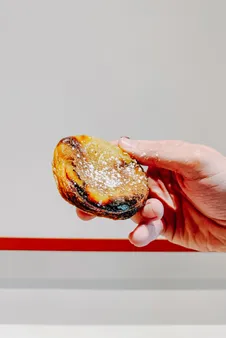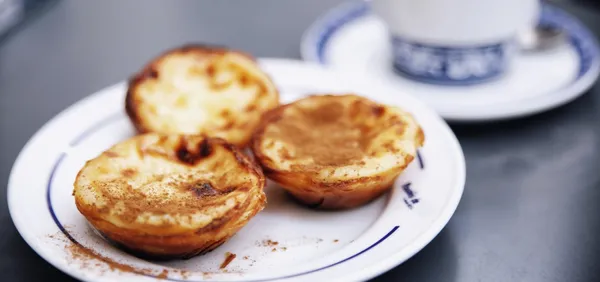Table of Contents
There's something truly magical about a perfectly crisp and flaky portuguese egg tart crust. At tauhuichiban, we understand the allure of this iconic pastry. Whether you're a seasoned baker or just starting out, mastering the art of the Portuguese egg tart crust is an achievable feat. Let's embark on a journey to create a crust that's as delightful as the creamy custard filling it holds.
Element | Description | Tips |
|---|---|---|
Flour | Use all-purpose flour for a balance of texture and flakiness. | - Sift the flour for a lighter crust. - Avoid overworking the dough to prevent gluten development and a tough crust. |
Fat | Traditionally, lard is used for its rich flavor and flakiness. Butter can be substituted for a milder taste. | - Keep the fat cold for optimal flakiness. - Cut the fat into small pieces for even distribution in the dough. |
Liquid | Use ice water to help control gluten formation and create a flaky crust. | - Add the water gradually, as the dough may not need the full amount. |
Technique | Proper lamination (folding and rolling) is crucial for developing layers in the dough, resulting in a flaky crust. | - Roll the dough evenly to ensure consistent thickness. - Chill the dough between folds to relax the gluten and prevent shrinkage. |
Baking | Blind bake the crust before adding the filling to prevent it from becoming soggy. | - Use pie weights or dried beans to prevent the crust from puffing up during blind baking. - Bake until the crust is golden brown and cooked through. |

Master The Portuguese Egg Tart Crust: A Deliciously Crispy Secret
Mastering the Perfect Portuguese Egg Tart Crust
Imagine sinking your teeth into a crispy, flaky Portuguese egg tart crust, giving way to a creamy, sweet custard filling. It's a pastry lover's dream come true! But, making the perfect Portuguese egg tart crust can be a daunting task, especially for beginners. Fear not, dear bakers, for we're about to dive into the world of flaky, buttery goodness.
The Importance of Quality Ingredients
When it comes to making a Portuguese egg tart crust, the quality of your ingredients can make all the difference. You'll need all-purpose flour, cold unsalted butter, and ice-cold water. Yes, you read that right - ice-cold water! It's essential for creating a flaky crust.
Ingredient | Quantity |
|---|---|
All-purpose flour | 2 cups |
Cold unsalted butter | 1 cup |
Ice-cold water | 1/2 cup |
The Art of Lamination
Lamination is the process of folding and rolling the dough to create layers, which gives the crust its signature flakiness. It's a bit like making a croissant, but with a few tweaks to get that perfect Portuguese egg tart crust.
Here's a pro tip: make sure to keep your butter cold, and don't overwork the dough. You want to create a delicate balance between the butter and flour, so the dough comes together in a shaggy mass.
Tips and Tricks for a Flaky Crust
Now that we've covered the basics, here are some additional tips to ensure your Portuguese egg tart crust is flaky perfection:
- Use a light touch when rolling out the dough to prevent developing the gluten.
- Don't overbake the crust - you want it to be golden, not brown.
- Let the crust rest for at least 30 minutes before baking to allow the butter to solidify.

Mastering the Perfect Portuguese Egg Tart Crust
The Anatomy of a Delicious Portuguese Egg Tart Crust
Ever wonder why Portuguese egg tart crusts are so unbelievably flaky? They're like edible puff pastry masterpieces! It's all about the magic of lamination, a fancy word for creating layers upon layers of buttery goodness. Think of it like building a delicious, edible skyscraper!
The Building Blocks of Flakiness: Flour, Fat, and Water
First, we start with the foundation – flour, fat (usually butter or lard – yum!), and a splash of ice-cold water. Now, imagine the flour as tiny little building blocks. The fat, all cold and solid, wants to hang out in between those blocks, creating space. When you add ice water, it helps glue everything together without letting the fat melt too quickly.
Ingredient | Why It Matters |
|---|---|
Flour | Provides structure and gluten for chewiness. |
Fat (Butter/Lard) | Creates air pockets for flakiness as it melts. |
Ice Water | Binds the dough without melting the fat. |

The Anatomy of a Delicious Portuguese Egg Tart Crust
Tips and Tricks for Achieving the Flakiest Portuguese Egg Tart Crust
Now that we've covered the basics, it's time to get flaky! A Portuguese egg tart crust that's as light as air requires some finesse, but don't worry, I've got your back. Here are some expert tips to ensure your crust is the star of the show.
Tips | Why It Matters |
|---|---|
Keep the butter cold | Prevents the butter from melting and creates a flaky crust |
Don't overwork the dough | Prevents the development of gluten, leading to a tough crust |
One of my favorite tricks is to use a light touch when rolling out the dough. Think of it as dancing on the dough - you want to gently guide it into shape without applying too much pressure. This will help prevent the development of gluten, which can lead to a tough crust.
- Use a pastry scraper to gently lift and rotate the dough as you roll it out.
- Keep the rolling pin lightly floured to prevent sticking.
By following these tips and tricks, you'll be well on your way to creating a Portuguese egg tart crust that's as flaky as the ones you find in Lisbon's famous bakeries. Happy baking!

Tips and Tricks for Achieving the Flakiest Portuguese Egg Tart Crust
Final Thought
Making a Portuguese egg tart crust doesn't have to be daunting. With a bit of practice and the right guidance, you'll be pulling perfectly golden, flaky masterpieces from your oven in no time. Remember, the key lies in the details: quality ingredients, precise techniques, and a dash of patience. So go ahead, embrace the journey, and savor the delicious reward of a homemade Portuguese egg tart with a crust that's simply unforgettable.